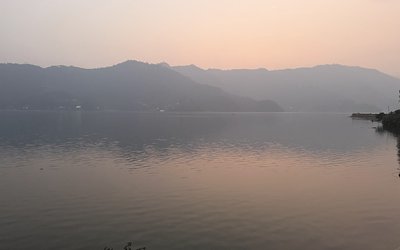
Nawalpur and Parasi are two of the luckiest districts of Nepal for having Narayani-Gandak Barrage built after the agreement signed between Government of Nepal and Government of India in 1959 and revised in 1964. The major tributaries of Narayani in Nepal are the Trishuli, Budhi Gandaki, Marsyangdi, Seti and Kaligandaki rivers. The average runoff (discharge) of Narayani at Narayangadh is around 1,600 cubic meters per second (m3/sec). The entry point of the Narayani/Gandak River at the Indo–Nepal border is also the confluence called Triveni with rivers Pachnad and Sonha descending from Nepal. Triveni in Nepal and Valmikinagar in India are the bordering cities to make the Gandak River a transboundary river.
The Gandak Agreement is based on the principles of enhancing the ‘common interests’ or ‘common benefits’ of Nepal and India from the Gandak river through the construction of barrage, irrigation canals and hydropower development. The Agreement particularly focuses on irrigation system and hydropower generation to meet the common interests of Government of Nepal and Government of India. For achieving the major goals of the Agreement, construction of barrage, a system of irrigation canals and Surajpur hydropower house were built.
Capturing the essence of the Agreement three main canals were built, which include Nepal Gandak Western Canal (NGWC); Western Gandak Canal (WGC) and Main Eastern Canal (MEC). The NGWC was built to irrigate an area of 8700 ha. land with a discharge of 8.5m3/s, however, the canal, and water control and distribution systems have deteriorated heavily as these infrastructures do not get regular maintenance. Even the intake of water in NGWC depends on the water level—at least 365 m for water to flow over the sill level of the canal— upstream of the barrage and at the mercy of the barrage operators, controlled by the Government of India. In theory, NWGC should not encounter any limitation in water supply in any time round the year but in reality supply is unreliable and uncertain and the canal does not even look like a canal compared to WGC and MEC. However, the article 9 of the agreement ensures that the government of Nepal “will continue to have the right to withdraw for irrigation or any other purpose from the river or its tributaries in Nepal”.
The WGC and MEC were built to irrigate large areas of land in Uttar Pradesh and Bihar respectively. The total area of land to be irrigated in India is 1.784 million ha. The MEC also feeds into the Nepal Eastern Canal (NEC) to provide 24.1 m3/s water to irrigate 37,000 ha of land in Bara, Parsa and Rautahat districts but this also does not seem to be happening when you visit the point from where water enters into Nepal side.
Although the spirit of ‘mutual benefits’ is highlighted in the Preamble of the Agreement, it does not appear to be so in praxis. Equitable sharing of water for irrigational purpose and generation of 15MW of electricity were the highlights of the Agreement but upstream user rights are compromised. The powerhouse of Surajnagar is to be producing 15 MW of electricity but it has never produced this amount and its current production capacity is between - 3MW to 4 MW only. The WGC and MEC canals irrigate lands located far beyond the Gandak basin areas however the impacts of the construction of WGC occur in the command areas of Nepal as this canal travels 19 KM in Nepali territory before it enter Uttar Pradesh (UP), India. Some of the fundamental impacts of the construction of Gandak Barrage and WGC include, regular flooding, water logging, prolonged inundation, riverbank erosion and change in river course, and disasters induced too much of water and no water for irrigation.
According to the people living in command area communities, there are three main reasons for floods, water logging and inundation. The first reason is that the NWGC and the WGC intercept the north-south flow of local streams and impede the natural draining system. The cross drainage works in the NWGC and WGC canals are deficient with poor maintenance resulting into about 4 months inundation in the monsoon and early winter period, rendering almost one-third of the command area in the south adjacent to the WGC out of crop cultivation. The faulty design of WGC, which extends 19 KM within the Nepalese territory, blocks the flow of spring water.
The second reason is the regular flooding in the Narayani River itself in rainy seasons affecting the communities and downstream areas of the barrage. The people who own riparian land downstream from the barrage have lost vast areas of lands due to regular flooding and erosion (Katan) yet they continue to pay land revenue tax with the hopes of receiving compensation from the concerned authorities in the future. The third reason is the seepage of water from WGC because of poor maintenance and faulty designs keeping the adjacent areas of the canal waterlogged, resulting into snakebites and many other water induced disasters.
In sum, the Agreement which was done to achieve mutual benefits for both countries sounded good in spirit but in praxis, it has brought more challenges compared to benefits in the riparian communities. For example, the NGWC looks completely dry throughout the year except in the rainy seasons as it was designed such a way to fulfill the motives of Indian irrigation interests and it has never been able to irrigate the lands of Nepal, which were expected to be irrigated. Second, the WGC intercepts natural flows of small waters and forces the north and southern areas of canal flooded and waterlogged causing huge losses of crops, contamination of drinking water system, increased snake bites and many other water induced disasters affecting lives and livelihoods of the people. Third, the private land areas of farmers adjoining to Narayani-Gandak river is continuously getting eroded, forcing people to quit homes and livelihood practices resulting into loss and damage of property and psychological sufferings.
The communities in the command areas of Nawalpur and Parasi in Nepal organized 34-day long sit-in strike in WGC against the disasters occurred by building the canal, resulting into signing of the 21-point agreement between Gandak River Control Struggle Committee and government of India. The members of struggle committee shared that a few points of the agreement were fulfilled, which included the blacktopping of the canal road in the command areas, construction 40 spurs and 1.5 meter height and width embankment wall in Triveni area (dam side), renovation of siphons, cleaning of the NGWC, renovation and coloring of the bridge railing, and construction of four bridges. However, the main problems related to disasters due to waterlogging and inundations and impacts on health and livelihoods are yet to be solved and the losses of yearly damages have not been compensated as agreed. The need for immediate revision of the Agreement to share equitable benefits of the international river and preparedness against ‘too much and too little of water’ resulting into water induced disasters remain as distant items on the agenda for now but they need immediate attention.

Dr. Chandra Lal Pandey
Dr. Pandey is the Program Coordinator and member of faculty at the Community Development Program, School of Arts, Kathmandu University.
- 16thPeriodic Plan for Delivering Basic Services and Fundamental Rights?
- Feb 08, 2024
- Disaster Governance: Theory And Practice In Nepal
- Dec 05, 2023
- Haphazard Urbanization Or Sustainable Smart Cities In Nepal?
- Jun 28, 2023
- Say No To Pre-Election Coalition
- Jul 14, 2022
- Nepalis Are Optimistic:Findings Of SNP 2020
- Apr 12, 2021












